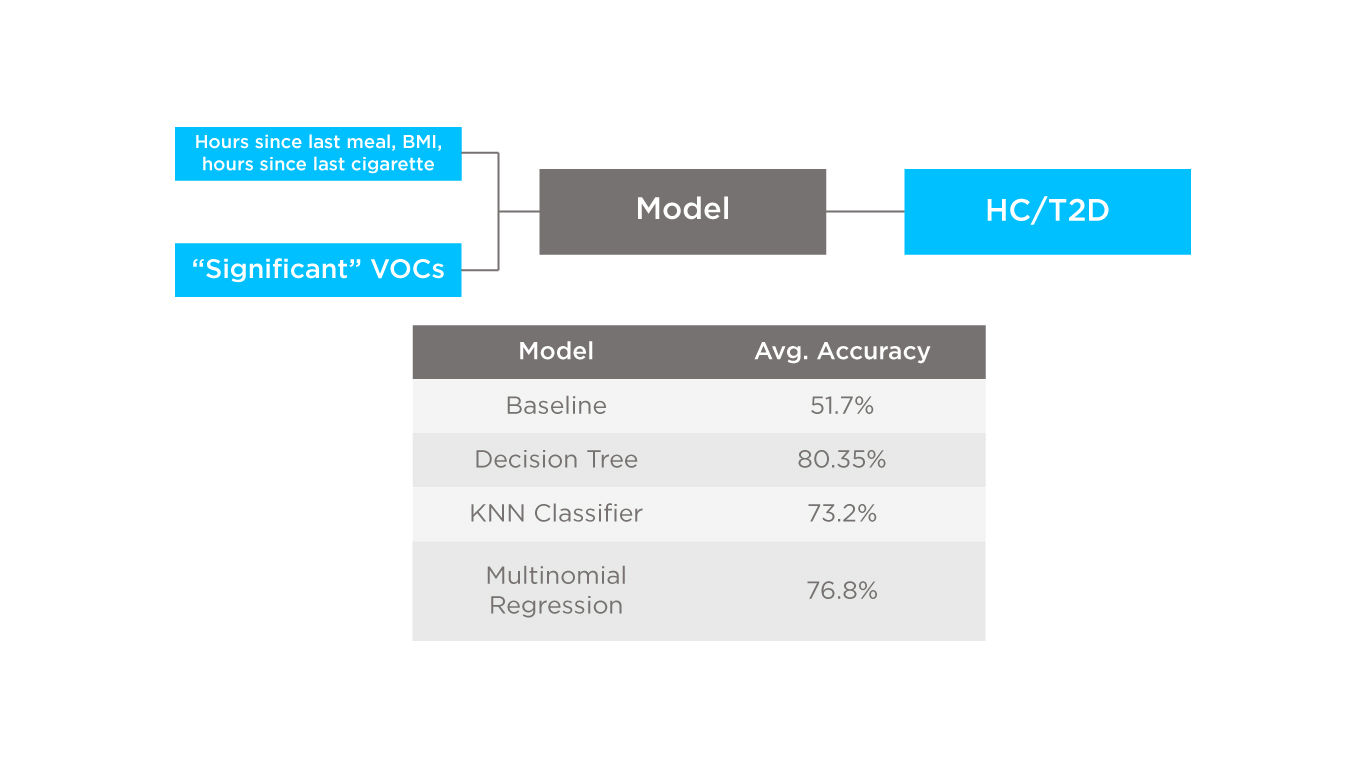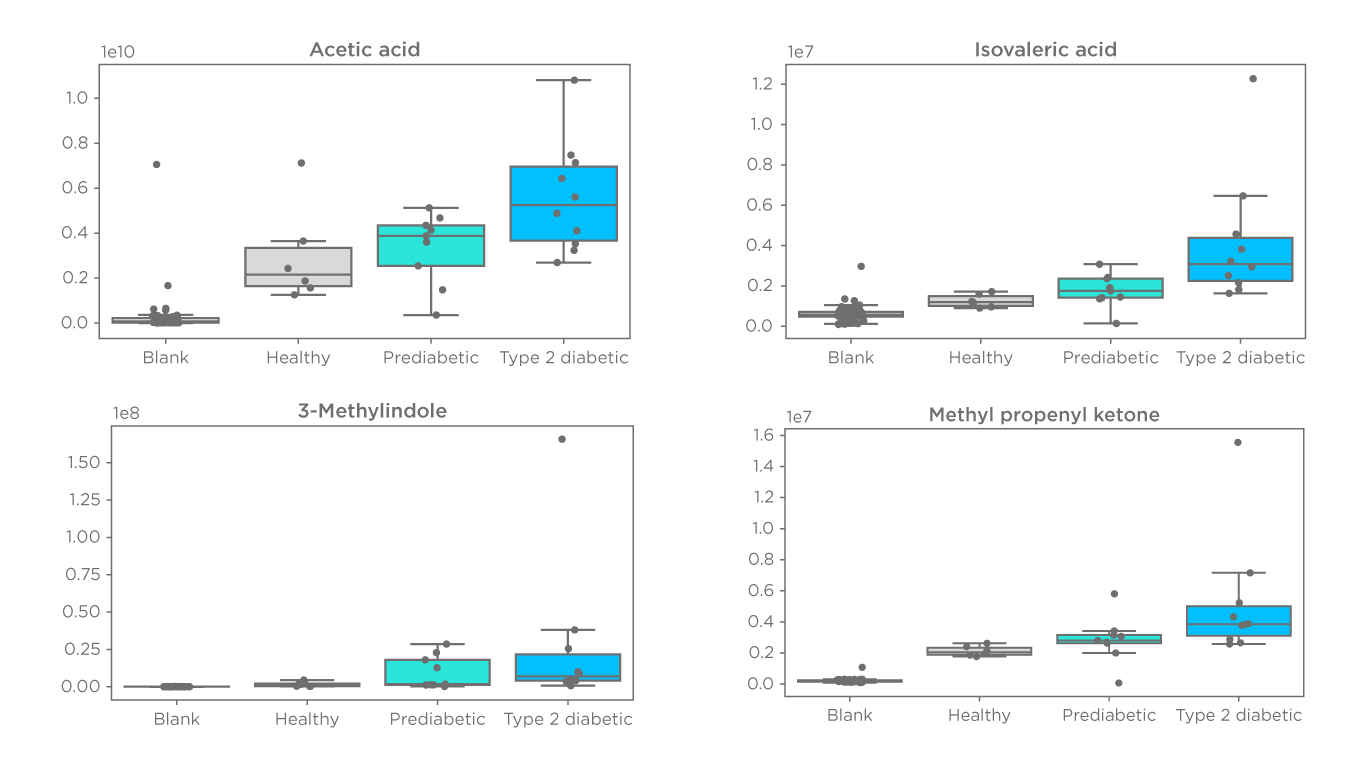Gasping Innovation – Unveiling Breath Biomarkers in Diabetic Subjects
Published on: 30 Nov 2023
VOCs in Diabetic Subjects.
Exhaled breath is a complex matrix, partially consisting of volatile organic compounds (VOCs). These volatile metabolites can be released directly into the breath by cells in the lungs, or can originate from other distal sites in the body. Volatile metabolites in the latter category can be carried by blood and exchanged with inspired air in the lung alveoli. VOCs have great potential as biomarkers for disease diagnosis and treatment monitoring; however, the current major challenge of breath research is the development of standardized, sensitive, and reproducible methods to quantify breath-based VOCs.
Owlstone Medical has developed the Breath Biopsy® OMNI® platform, optimized specifically for the confident identification and analysis of compounds from exhaled breath. To demonstrate the platform’s capability, we conducted a study on type two diabetic (T2D) subjects, a disease with well-established blood metabolite biomarkers in the literature. Through evaluating breath VOCs that differ in abundance among T2D, prediabetes (PD), and healthy controls (HC), the goal was to identify whether any of these blood compounds can be volatile and detected in exhaled breath, in addition to new potential breath biomarkers.
T2D is a complex metabolic disorder defined by the continuation of elevated blood glucose levels (BGL > 126mg/dL at fasting) and progresses from prediabetes (PD) (BGL 100-125mg/dL at fasting). The condition of T2D is associated with several long-term trends, including high-calorie intake, changes in the gut microbiota, and lack of exercise. Individuals with T2D rely on continuous blood glucose monitoring and, in more severe conditions, on drug therapy to manage their condition and prevent the development of other co-morbidities.
Study Design and Data Analysis
In this study, we recruited a total of 76 volunteers from T2D, PD, and HC groups, well balanced across sex and age categories. To be included in the study, participants must have a BMI above 25; regardless, BMI remained a significant covariate across different groups. Along with smoking status, these two covariates were taken into consideration in later statistical analysis.
Breath Biopsy samples were collected using the ReCIVA® Breath Sampler and analyzed with thermal desorption gas chromatography mass spectrometry (TD-GC-MS) using the Breath Biopsy OMNI Platform. After the removal of low-abundance compounds and imputation of semi-present compounds for statistical analysis, compounds were assigned with IDs following the MSI standards [1]:
Tier 1 IDs- confirmed with reference standards run either in the same sequence or equivalent sequence. Tier 2 IDs- putatively assigned through comparison to Owlstone Medical’s HRAM library.
Tier 3 IDs- tentatively assigned through comparison to the NIST library.
In our statistical analysis, we observed that the data distribution of fasting duration was separated into two groups despite not being a significant covariate. Therefore, we focused on subjects that fasted over 8 hours for a more accurate reflection of disease-associated metabolic changes. We tested three different prediction models to determine whether the breath profiles in different groups could be utilized to train a predictive model for diagnosing diabetes (Fig 1).
The inputs of these models were the concentrations of significant VOCs in subjects with over 8 hours of fasting, BMI, hours since the last cigarette, and hours since the last meal. In comparison to baseline accuracy, all three models performed well, with the decision tree exhibiting the best performance, achieving an average accuracy of 80.4%.

Key findings on selected VOCs
In this study, a total of 96 VOCs reached statistical significance among T2D, PD, and HC groups. We focused on compounds with low background levels (see our blog about breath or blank study design) and those that exhibit a significant increase in T2D with a consistent trend between T2D, PD, and HC. By narrowing down the compounds through these approaches, these key VOCs are more likely to be biologically relevant and reflect disease progression.
VOCs related to the microbiome: acetic acid, isovaleric acid, and 3-methylindole
Acetic acid is a short-chain fatty acid (SCFA) produced by gut bacteria. Levels of breath acetic acid have been found significantly increased in diabetic subjects in previous studies [2]. Isovaleric acid is also a SCFA and could be produced by either gut bacteria fermentation of leucine or dietary sources. Increasing levels of serum isovaleric acid in subjects with gestational diabetes were found in a previous targeted metabolomics study [3]. 3-Methylindole is a VOC in the tryptophan pathway.
Compounds in the tryptophan pathway such as indole and indolepropionate are known to be relevant to the disease, putatively modulating glucose metabolism [2],[4].
VOC related to disruption in metabolic processes and (gut) inflammation: methyl propenyl ketone
While the actual mechanism remains unknown, increased levels of methyl propenyl ketone have been found to be associated with several diseases such as nonalcoholic fatty liver disease (NAFLD) and ulcerative colitis (UC) [5, 6].

Additional VOCs found significantly increased in T2D with unknown biological relevance include the tentatively identified γ-undecalatone, 3-pyridinol, and an unknown compound.
The findings in this study show that the significant breath VOCs found using our Breath Biopsy OMNI Platform are capable of distinguishing different cohorts. In addition, several of these compounds also reflect interesting physiological associations with the complex metabolic disorder of diabetes, such as metabolic processes, inflammation, the gut microbiome, and exposure.
For future metabolic disease studies, a larger number of participants fasted overnight will ensure better baseline status. Similarly, a population of treatment-naïve subjects will serve as a better cohort for identifying biomarkers for disease diagnosis and prediction.
The Breath Biopsy OMNI Platform is designed to explore a wide range of clinically relevant research questions. At Owlstone, we possess the expertise to assist you with your study design and to deliver high-quality results. If you are interested and would like to incorporate the Breath Biopsy OMNI into your research, please reach out to us. Our team is happy to engage in further discussion to understand your specific requirements and provide tailored assistance.
References:
- Sumner, L.W., et al., Proposed minimum reporting standards for chemical analysis Chemical Analysis Working Group (CAWG) Metabolomics Standards Initiative (MSI). Metabolomics, 2007. 3(3): p. 211-221. DOI: 10.1007/s11306-007-0082-2.
- Fink, H., et al., Indole as a new tentative marker in exhaled breath for non-invasive blood glucose monitoring of diabetic subjects. J Breath Res, 2022. 16(2). DOI: 10.1088/1752-7163/ac4610.
- Gao, Y., et al., Alterations of gut microbiota-derived metabolites in gestational diabetes mellitus and clinical significance. J Clin Lab Anal, 2022. 36(4): p. e24333. DOI: 10.1002/jcla.24333.
- de Mello, V.D., et al., Indolepropionic acid and novel lipid metabolites are associated with a lower risk of type 2 diabetes in the Finnish Diabetes Prevention Study. Sci Rep, 2017. 7: p. 46337. DOI: 10.1038/srep46337.
- Raman, M., et al., Fecal microbiome and volatile organic compound metabolome in obese humans with nonalcoholic fatty liver disease. Clin Gastroenterol Hepatol, 2013. 11(7): p. 868-75 e1-3. DOI: 10.1016/j.cgh.2013.02.015.
- Garner, C.E., et al., Volatile organic compounds from feces and their potential for diagnosis of gastrointestinal disease. FASEB J, 2007. 21(8): p. 1675-88. DOI: 10.1096/fj.06-6927com.
